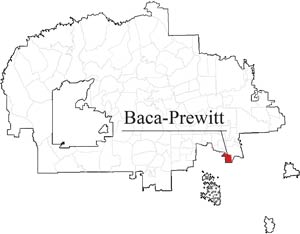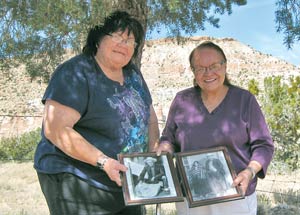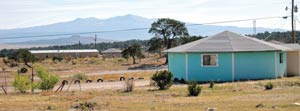Where it all started
New Mexico's uranium boom can be traced to Baca-Prewitt
By Cindy Yurth
Tséyi' Bureau
BACA, N.M. , October 11, 2012



(Times photo — Cindy Yurth)
TOP: Two of Paddy Martinez' daughters, Mae Lynch and Flora Dimitriou, pose with pictures of their parents under the piñon tree where Martinez was resting when he happened to see a yellow rock that turned out to be uranium. Haystack Mountain can be seen in the background.
BOTTOM: Many Baca/Prewitt residents, like the occupants of this blue hogan, have stunning vistas of Mount Taylor, the southern sacred mountain.
(Editor's note: In an effort to portray the beauty and diversity of the Navajo Nation, as well as its issues, the Navajo Times has set a goal of visiting all 110 chapters over the next two years. This is the fourth in the series.)
T
his may be the only Navajo chapter whose most famous son had red hair and freckles.
It was in Baca/Prewitt Chapter, at the base of Haystack Mountain, that the Navajo-Irish medicine man known as Paddy Martinez found the yellow rock that started northern New Mexico's uranium boom of the 1950s, 60s and 70s.
Martinez passed away in 1968, but four of his 13 children are still alive, and when the Times visited Baca/Prewit as part of its quest to chronicle life in all 110 chapters, we were fortunate to meet three of them.
And although their family sometimes gets blamed for the cancers that accompanied uranium mining, they're happy to share the story of their ineffable father and that fateful day in 1950.
Paddy Martinez' early history is a bit murky.
"He never really told us where he came from," said his daughter Flora Dimitriou, 65. "I guess he just figured it was none of our business."
But folks in this small community are liberal with the gossip and this is the story as his kids heard it from some of Martinez' contemporaries.
It had been an exceptionally lean year, and Paddy's mother had been left alone to provide for her children while their father was off "fighting some war or another," Dimitriou recounted.
Her husband came home from the battlefield to find her carrying a baby with red hair and freckles.
"That's not my child!" he exclaimed.
His wife explained that, with no other recourse to feed their family, she had slept with the Irish trader in exchange for groceries.
As the boy grew, it was evident he was different from his half-siblings in more ways than color.
"He was more energetic, outgoing, curious and a little bit naughty," Dimitriou said.
A family friend suggested farming him out to a Mexican family in San Mateo, N.M., in the hopes of straightening him out. That was where he got both his surname, Martinez, and his first name.
"Back then people just had their Indian names," Dimitriou explained. "Since he was half-Irish and the Mexicans knew all Irishmen were named Paddy, that's what they started calling him."
Paddy Martinez came back to the reservation 13 years later, untamed and swearing in Spanish.
The family once again farmed him out, this time to a bilagáana family.
By the time Martinez was old enough to strike out on his own, he was fluent in Navajo, Spanish, and English and passable in Laguna and Acoma.
He hadn't had a day of school, however. He learned things by listening.
Eventually, Martinez married a Navajo girl and established a homestead near Haystack.
Fateful errand
It's his wife, Flora, who probably deserves the credit or blame for the uranium boom as much as Paddy, for it is she who sent him out on the errand that changed everybody's life.
"She ran out of baking powder," said Mae Lynch, 67, another of Martinez' surviving children. "So off he went on his horse to the trading post."
On his way back, Martinez dismounted to take a nap under a tree. A bright yellow rock caught his eye.
"He picked it up, and he remembered some men in Grants talking about a yellow rock," Lynch said. "They were saying it's worth a lot of money, and it's supposed to be somewhere in New Mexico."
Martinez took the rock back to the trading post and showed it to the trader, who joked, "Oh, Paddy, you just want some money so you can buy yourself something to drink!"
But he sent the rock to a lab in Kansas, and the results came back positive. It was uranium ore.
Word spread quickly, the "Grants Mineral Belt" was soon swarming with prospectors, and everybody knows the rest of the story.
As for Paddy Martinez, the ore he found turned out to be on Santa Fe Railroad right-of-way.
"If he had filed a claim, he might have been rich," Dimitriou said. "But back then, there wasn't a lawyer standing behind every person like there is now, and he didn't know to do that."
As it was, Paddy did all right. The railroad offered him his choice of $10,000 at once or $250 a month for the rest of his life. He chose the latter, which turned out to be the right decision, since he lived to the age of 91. He saved up his stipend and bought a ranch at Bluewater Village, building a sprawling house for his large family.
Flora Martinez, who was considerably younger than her husband, died in 2006 at the age of 105.
Switching horses
Many members of Baca/Prewitt chapter worked in the uranium industry, and even those who didn't were exposed to radiation as they used rocks chipped from the mines to build their hogans, noted Juan Martinez, 62, Paddy's youngest child.
"I remember when the BIA closed our well down out in Haystack," said Dimitriou. "But by then, we had already been drinking from it for years. Us and all our livestock."
A Navajo scientist, Christine Samuel-Nakamura, is currently researching the effects of radiation on the local Diné.
The boom fizzled rapidly in the mid-1970s, when large deposits of the radioactive mineral were found in other countries, particularly Australia.
With prices rebounding, uranium is making a comeback in some places, but Baca/Prewitt is hitching its wagon to a different horse.
Chapter Coordinator Sharon Francisco revealed that the chapter is currently negotiating with a solar power company for a plant that will employ 500 people — nearly a fifth of the chapter's population.
A checkered present
Unlike at many other chapters, infrastructure is not a problem at Baca/Prewitt, which straddles I-40 between Grants and Gallup and gets its electricity from the Continental Divide electrical cooperative.
"If we can attract 500 new jobs, we might be able to convince NHA to build us some housing for the workers," Francisco said.
Meanwhile, the chapter is cleaning up some problems dug up during a recent Navajo Nation audit and working toward certification, which could come as early as next spring, she added.
While the chapter is between two urban areas and right on the freeway, development is hampered by its checker-boarded edges, which include parcels of BLM, state, private and allotted land. There's only one freeway exit for the 127,000-acre chapter comprising five communities; negotiations for a second one have been under way for years and involve at least three different entities with rights of way.
In the meantime, chapter residents cross the freeway by driving under it, through five one-lane culverts they refer to as "the tunnels."
"I don't think they were originally meant for people to drive through," said Francisco. "People just started doing it."
On the lone freeway exit sits the Tomahawk Bar, on a piece of private land just across and down the street from the chapter's only elementary school.
"If you ask my grandson where he goes to school," says Lynch with a grin, "he'll tell you, 'Across the street from the bar.'"
A much nicer landmark is Tzoodziil, Mount Taylor — the Navajos' southern sacred mountain is visible from most places in the chapter. It spreads its purple skirts serenely on the southeastern horizon, another survivor of the uranium boom, which at one time crept up its flanks almost to its 11,000-foot summit.
"You just look up, and there it is," Dimitriou said. "It's a really nice thing about living here."

